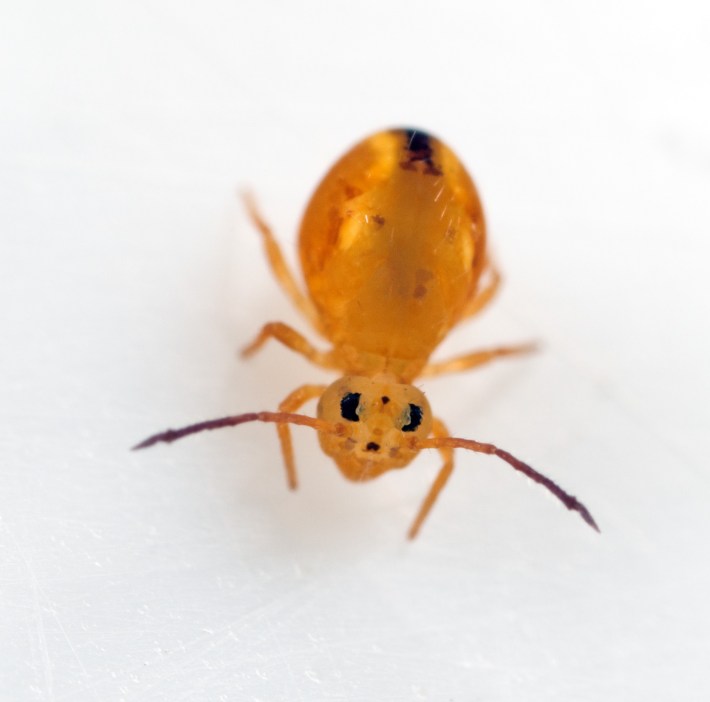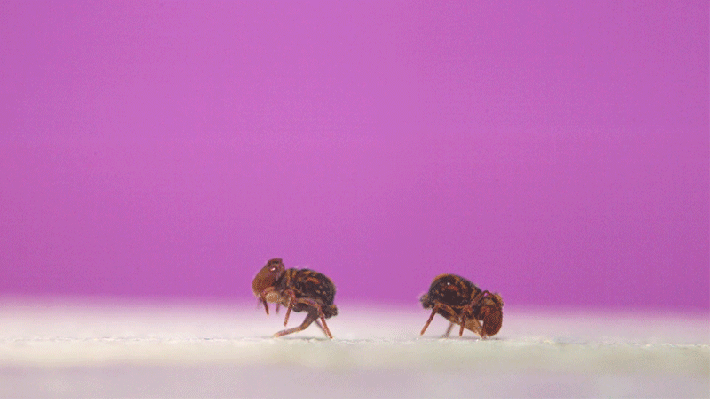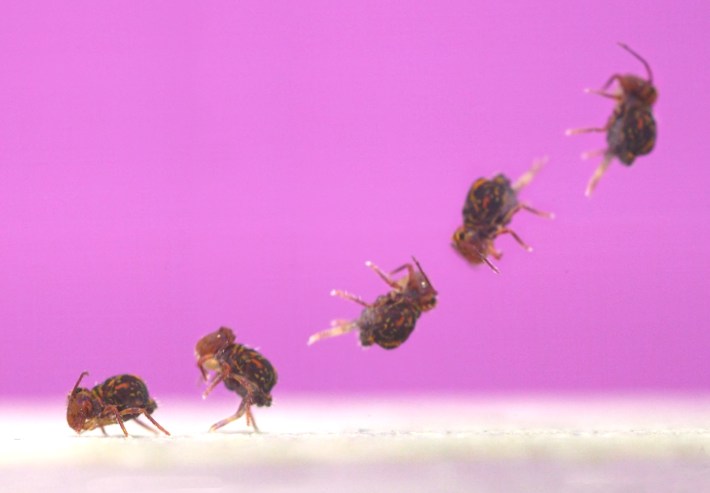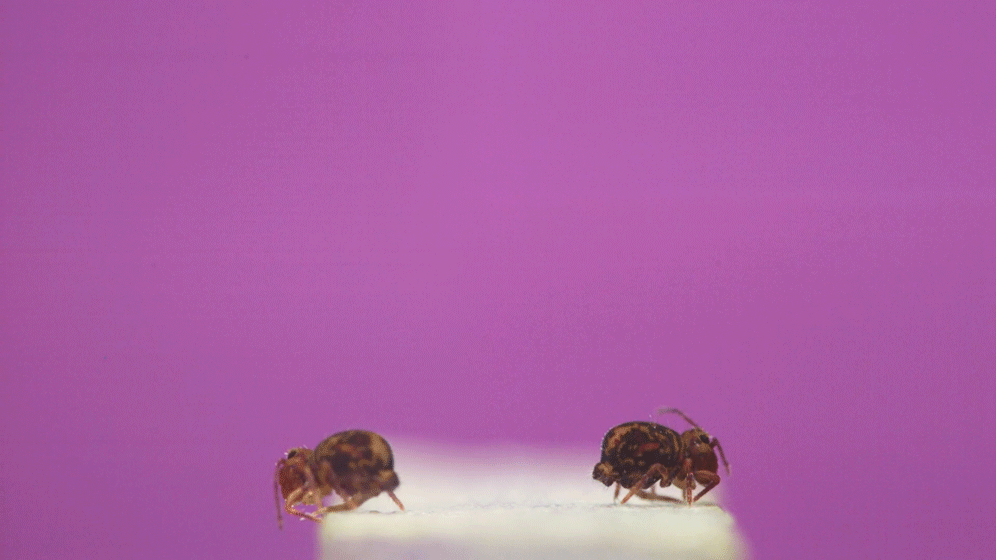At a glance, the globular springtail might seem a chubby bug. It has a small head, big black eyes, and a body shaped almost perfectly like a ball. But while the springtail is certainly plump, it is not an insect but a hexapod—a member of a class of arthropods that include the aptly named two-pronged bristletails and the inconsiderately named coneheads. Springtails are also aptly named, for their ability to leap into the sky to avoid being eaten, smushed, or any of the other fates that might await a creature the size of a chia seed.
Springtails generally come in three shapes: some look like roly-polies and others have have elongated bodies, built like a wiener or a brat. The last group are the globular springtails, which are "dumpy in shape," write two researchers from Virginia Tech in a pamphlet. These bulbous bodies are no barrier to the springtail's high-flying gymnastics. Globular springtails can jump so high and so quickly that they appear, almost miraculously, to vanish.
When researchers filmed one species of globular springtail, Dicyrtomina minuta, they found the hexapod can leap up to 60 times its body height and spins as fast as 368 times per second in a jump that lasts just 161 milliseconds. Adrian Smith, an entomologist at North Carolina State University in Raleigh and Jacob Harrison, a researcher at the Georgia Institute of Technology, recently recorded these observations in a paper in Integrative Organismal Biology. "This paper is amazing because the videos are fantastic," said Victor Ortega Jiménez, a biomechanics researcher at the University of California, Berkeley, who was not involved with the research.
Springtails hurl themselves around soils and ponds across the Earth, from the Arctic to the Antarctic. If you have a backyard, they are probably there at some point of the year, wandering around the leaf litter (check out this springtail fancam to see the tiny fellows in the wild). Smith first came upon globular springtails in his backyard in the winter. Although the rotund critters were small, they were not hard to find. When Smith sifted through the leaf litter, he found a trove of spiders, mites, pseudoscorpions, and globular springtails. He used a tool called an aspirator, which is essentially a mouth-powered vacuum, to "suck them up and sort of sneak up on them," Smith said. He then sent the springtails to taxonomic experts, who identified the species as Dicyrtomina minuta, which is rather charming close up.

The diminutive size and anatomical creativity of many arthropods give them an edge for extreme jumping. Insects called froghoppers can leap across distances more than 100 times their body length. Legless gall midge larvae can leap across distances up to 30 times their body length. Springtails owe their jumping prowess to an appendage called a furca, a modified abdominal segment that the springtail usually keeps folded underneath its body. In order to leap, a springtail flicks its furca against the ground to catapult itself into the sky.
For a long time, the small size of springtails has shrouded the exact mechanics of their leapings and landings in mystery. In 2022, Ortega Jiménez and colleagues published a paper containing high-resolution, slowed-down videos of semi-aquatic springtails, which can land in the same spot from which they leaped. These springtails are not globular but elongate, allowing them to bend their body into a U-shape, Ortega Jiménez said. "That U-shape is important because it's very stable," he said. These semi-aquatic springtails use their furcas to flip into the air and extend a retractable tube in their abdomen called a collophore to direct where they fall and stick to the water upon landing.
Smith wanted to get up close to a globular springtail to see how its furca and collophore behaved during a jump. "When you see it in real life, it looks like the thing teleports," he said. "It's instantaneous." The researchers placed the springtails on a flat piece of acrylic blanketed in masking tape to add a little grip. Then they filmed at over 40,000 frames per second to capture the moment the springtail flips its furca to launch itself, which happens faster than the blink of an eye. The slowed-down video captures the springtail whirling gracefully in slow motion.

While the slender semi-aquatic springtails landed with ease and finesse, the globular springtails largely crash-landed in random directions. Globular springtails do not have a body that is long enough to bend, Ortega Jiménez pointed out. "They are small balls jumping," he said. "They cannot do many things with their legs, so they keep rotating."
When the springtails jumped in response to an all-around stimulus of light, they always landed behind or to either side of where they started. Even when Smith nudged them in one direction with the tip of a paintbrush, they still mostly landed behind or to the side of their starting position. It was impossible to predict where the hexapods would land, so the researchers trained the camera to a single spot and then filmed, hoping a springtail would land in that spot. "Dumb luck until it shows up on camera," Smith said.
Filming the challenges of filming an itty-bitty arthropod intent on flinging itself in somewhat random directions presented some expected challenges. Some subjects went missing after particularly spectacular jumps. Smith runs a YouTube channel called the Ant Lab, where he published a video about the globular springtails, including footage of his filming setup. "I cut out the parts where I'm like on my hands and knees looking for them on the ground," Smith said.

Eventually, the researchers did manage to film a landing, revealing the springtails had two strategies for returning to land. In one, the springtails unfurled their collophores to anchor themselves on the ground. In the other, the springtails chaotically tumbled in a series of bounces. "It's not the most graceful thing, but it works," Smith said. Semi-aquatic springtails need to land well so they are ready for their next jump, to avoid a bounty of predators including water striders and fish, Ortega Jiménez said. But on land, the globular springtails might face less predation pressure. "Maybe that's why they don't mind if they are just bouncing," Ortega Jiménez speculated. "If you are bouncing randomly, the predators cannot follow you," he added.
While landing well is crucial for a person or a cat to avoid damaging their vital organs, this concern is diminished in an animal as small as a springtail. I asked Smith if jumping so high disorients the little guys. "It might look like falling from a distance of 60 body lengths is severe and you would be like knocked out," he said. But springtails have such little mass that falling from such a distance does not crush their body the way it would ours. "They're just bouncing and getting on with their day," he said. "They live at a totally different scale than we do."
And it's only now, with high-speed cameras, that we are able to glean how much a springtail can achieve in a millisecond. The springtails move in a way that is incomprehensible to our own sensory understanding of the world, so it follows that we need special tools to comprehend the world as a springtail would. So Smith never describes his footage as slow-motion, a word that betrays our human bias. As he sees it, "it's just, you know, their own motion."






